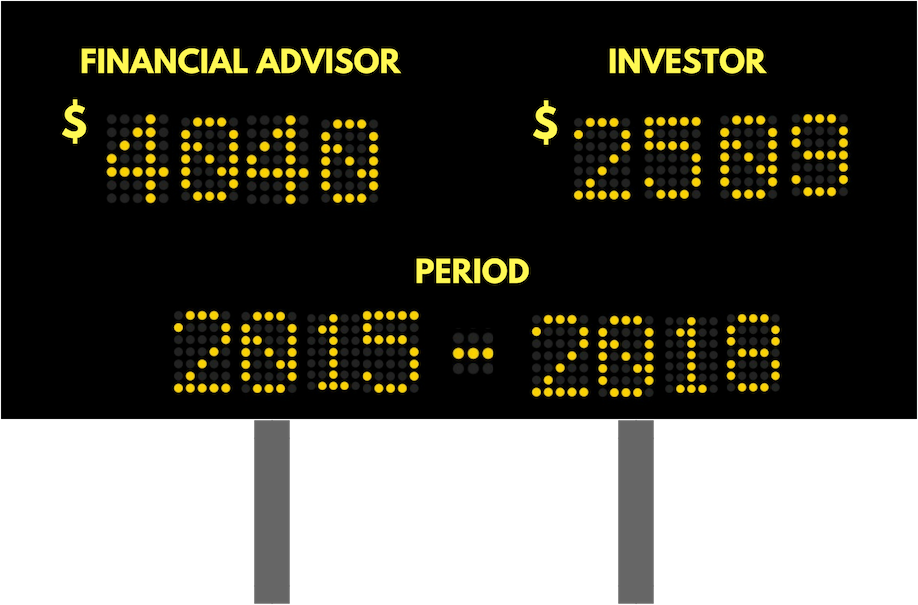The goal of financial advisors and investment newsletters should be to empower customers to increase their investment returns after all fees paid by investors. A key component of this is ensuring financial advisor costs and newsletter subscriptions are small relative to the investment returns being generated by these service providers' investment recommendations. This is Job #1 at BondSavvy, where, for subscribers buying 5 bonds of each BondSavvy recommendation made from our first set of recommendations through our last on May 31, 2019, subscribers achieved $35 in investment return for every dollar paid in BondSavvy subscription fees.
Unfortunately, the opposite is true when investors use traditional financial advisors who charge 1% of assets and place investors in underperforming bond funds and bond ETFs. This fixed income blog post shows the unfortunate case where financial advisors placing clients into the world's largest bond fund, Vanguard Total Bond Market Index Fund (Ticker: VBTLX) between 2015-2018 made more money in financial advisor fees than their clients did in after-fee investment returns.
The Vicious Financial Advisor to Bond Fund Circle
Many people invest in fixed income through Vanguard bond funds or BlackRock iShares bond ETFs. Unfortunately, bond fund returns are often weak, and these investments lack the many advantages of individual bonds. Many investors compound this problem by investing in bond funds through their financial advisors who charge 1% of client assets for the ‘service’ of placing clients into underperforming bond funds.
The problem with this is that the financial advisor is doing this not because it's best for the client but rather because he doesn't know much about fixed income investing. The advisor would rather absolve himself of the responsibility of making difficult bond investing decisions on behalf of clients. It's one thing to invest a client into Alphabet stock, but creating a solid individual bond portfolio requires significant expertise that is typically lacking from the financial advisor community.
Since bond fund returns are typically low, a financial advisor's 1% fee can be a significant part of the return a bond fund achieves. Here’s how this advisor to bond fund circle works to benefit the financial advisor and Vanguard, but not the individual investor:
Figure 1: Biggest Bond Investing Mistakes
Biggest Investment Mistake #1:
Investor invests $100k fixed income portfolio through a financial advisor not 'savvy' in bonds.

Biggest Investment Mistake #2:
Financial advisor, lacking any bond investing expertise, takes 1% annual fee and places $100k into a mega Vanguard bond fund, which, in turn, charges more fees.

An investor return lower than inflation
Due to the low Vanguard bond fund returns and the 1% annual financial advisor fees, the investor earns less return on his $100k investment than his advisor makes on annual fees.

Biggest Investment Mistake #3:
The $200+ billion Vanguard Total Bond Market Index Fund, which includes the Admiral Shares class (VBTLX), the BND ETF, and other share classes, is so big that it owns over 8,000 bonds and is not a discerning investor. It owns what the index tells it to own. The bond fund averages a weak 1.63% annual return from 2015-2018.

After financial advisor fees and Vanguard bond fund fees, the investor averaged an annual return of 0.63%, as the financial advisor earned 1.0% on the client’s assets. From 2015-2018, the financial advisor who prescribed investing in Vanguard Total Bond Market Index Fund made $4,040 compared to the client’s $2,509 return on investment as shown in Figure 2. This is a poor investor outcome no matter how you cut it, and we call it the VBTLX Road to Nowhere. It shows how important it is for individual investors to reduce costs and increase bond investment returns by making direct investments in individual corporate bonds.
Figure 2: Financial Advisor Fees vs. Investor Returns

